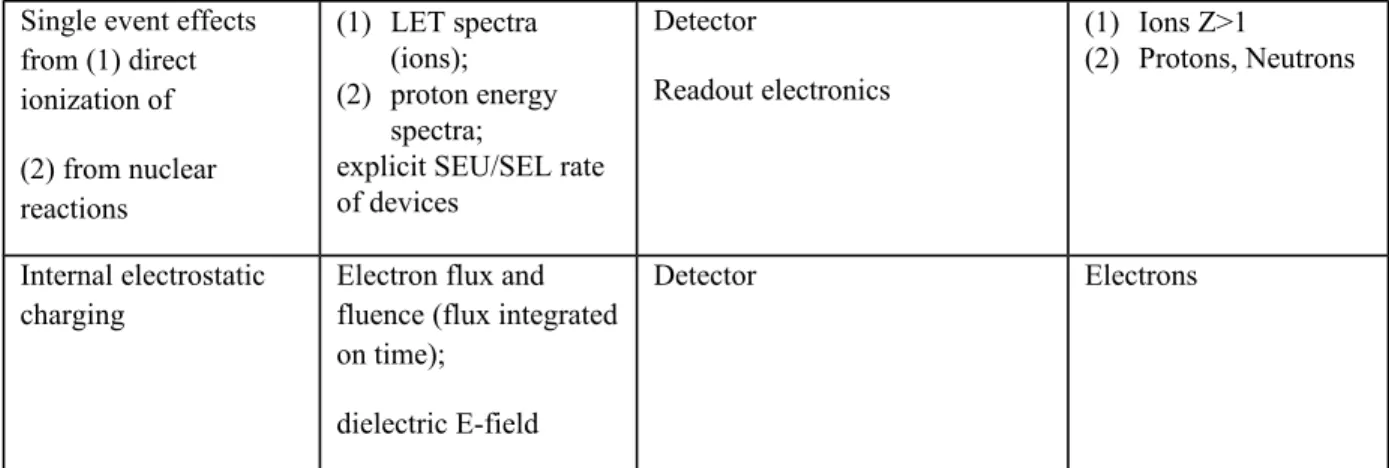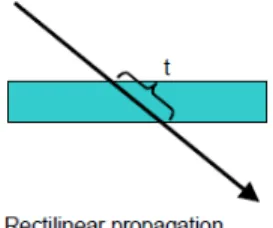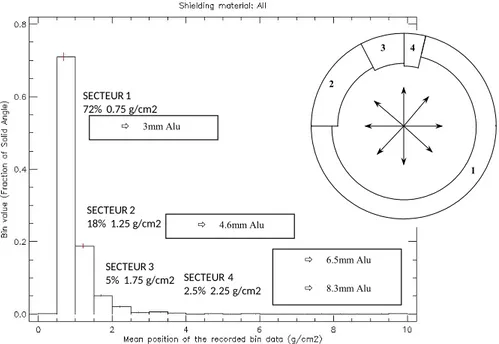Space radiation parameters for EUI and the Sun Sensor of Solar Orbiter,
ESIO and JUDE instruments
Laurence Rossi
a 1,Lionel Jacques
a, Jean-Philippe Halain
a, Etienne Renotte
a, Tanguy Thibert
a, Denis
Grodent
ba
Centre Spatial de Liège, Université de Liège, Liege Science Park, 4031 Angleur, Belgium,
http://www.csl.ulg.ac.be/
b
Laboratoire de Physique Atmospérique et Planétaire, Université de Liège,
http://www.lpap.ulg.ac.be/
ABSTRACT
This paper presents predictions of space radiation parameters for four space instruments performed by the Centre Spatial de Liège (ULg – Belgium); EUI, the Extreme Ultra-violet Instrument, on-board the Solar Orbiter platform; ESIO, Extreme-UV solar Imager for Operations, and JUDE, the Jupiter system Ultraviolet Dynamics Experiment, which was proposed for the JUICE platform.
For Solar Orbiter platform, the radiation environment is defined by ESA environmental specification and the determination of the parameters is done through ray-trace analyses inside the EUI instrument.
For ESIO instrument, the radiation environment of the geostationary orbit is defined through simulations of the trapped particles flux, the energetic solar protons flux and the galactic cosmic rays flux, taking the ECSS standard for space
environment as a guideline. Then ray-trace analyses inside the instrument are performed to predict the particles fluxes at the level of the most radiation-sensitive elements of the instrument.
For JUICE, the spacecraft trajectory is built from ephemeris files provided by ESA and the radiation environment is modeled through simulations by JOSE (Jovian Specification Environment model) then ray-trace analyses inside the instrument are performed to predict the particles fluxes at the level of the most radiation-sensitive elements of the instrument.
Keywords: radiation, ray-trace, ionizing dose, non-ionizing dose.
1. INTRODUCTION
1.1 EUI instrument
Solar Orbiter is a mission dedicated to solar and heliospheric physics. It was selected as the first medium-class mission of ESA's Cosmic Vision 2015-2025 Programme. It will be launched in 2017 (baseline) and is devoted to solar observation from an elliptical orbit around the Sun approaching to 60 solar radii. It will provide unprecedented close-up and high-latitude observations of the Sun.
1
The EUI instrument [1], [8] is composed of two high-resolution imagers (HRI), one at the hydrogen Lyman-α line (HRI Lya) and
one in the extreme ultra-violet (EUV) at 174 Ǻ (HRIEUV) (figure 1); and one dual band full-sun imager (FSI) working
alternatively at the two 174 Ǻ and 304 Ǻ passbands (figure 2).
Figure 1: EUI instrument (Structural and Thermal Model) placed on the CSL shaker table
Figure 2: Full Sun image (top) and high-resolution Sun image (bottom) [1]
1.2 ESIO instrument [2]
ESIO is a small, lightweight prototype solar EUV telescope and solar UV flux monitor for monitoring and forecasting of space weather phenomena with autonomous data processing capabilities.
Developed under GSTP-5 program, the ESIO project is not linked to a specific mission. The project activities correspond to phases A to C in a mission life cycle, completed with development and test activities at breadboard and component level. The ESIO instrument is a low resolution, low data rate, compact solar EUV imager associated to a flux monitor for operation use in space weather monitoring and forecasting (figure 3). The instrument is capable of autonomous data processing for optimal bandwidth usage in data transmission.
The 17.5nm EUV imager (EUVIM)
The EUV radiometer (UVMON), with a double redundant Zr channel and one Lyman-alpha channel
The Instrument Control Unit (ICU)
The imager and the radiometers are mounted on a single compact structure, forming the Optical Assembly (OA). Under the optical assembly is the Front End Electronics Assembly (FEEA), which contains the minimum electronics required in the vicinity of the sensors. The FEEA is able to deliver raw data to a processing unit on demand.
The Instrument Control Unit is a piece of companion avionics that provides TC/TM interface with the platform and power conditioning. It also provides dedicated capabilities for instrument autonomy, processing and storage of data, and control of electromechanical
equipment. Figure 3: View of the CAD model of ESIO instrument (optical unit
and instrument control unit)
1.3 JUDE instrument[4]
JUICE[3] (JUpiter Icy moons Explorer) will continuously observe Jupiter’s atmosphere and magnetosphere, and the
interaction of the Galilean moons with the gas giant planet.
It will visit Callisto, the most heavily cratered object in the Solar System, and will twice fly by Europa. JUICE will make the first measurements of the thickness of Europa’s icy crust and will identify candidate sites for future in situ exploration. The spacecraft will finally enter low altitude circular orbit around Ganymede in 2032, where it will study the icy surface and internal structure of the moon, including its potential subsurface ocean.
Ganymede is the only moon in the Solar System known to generate its own magnetic field. JUICE will perform detailed observations of the unique electromagnetic and plasma interactions of Ganymede with Jupiter’s magnetosphere.
The science objectives of the JUICE mission rely extensively on the UV instrument. JUDE was specifically designed to address the UV-related objectives as defined in the Science Requirements Matrix as part of the ESA JUICE AO package. At the same time, JUDE was meant to offer a simple innovative combination of robust technologies. It consisted of two separate, complementary channels: an imager providing high spatial resolution time-tagged images (ImaC) and a high-resolution spectrograph (SpeC) (figure 4).
Figure 4: CAD views of JUDE instrument (left) and optical model view of JUDE (telescope and spectrograph)
2. RADIATION SENSITIVE SUB-SYSTEMS
Radiation effects include :
Total integrated dose effects on electronics and materials (degradation)
Displacement damage effects on opto-electronics and materials
Interference with detector operation (background)
Non destructive Single Event phenomena (upset, transient, functional interrupt) Destructive Single Event phenomena (latchup, burnout, gate rupture and hard error)
Electrostatic charging
2.1 EUI instrument
EUI is composed of radiation sensitive components. First the electronic and electro-mechanical elements: the front end electronics of the three detectors, containing the FPGA, the memories and the AD converters, the motor of the filter-wheel of the lyman-alpha and the EUV channels, the doors mechanisms, the high voltage unit of the lyman-alpha channel and the detectors. Second the mirrors EUV coatings, the entrance baffle coating and the entrance filter. These sub-systems and elements are shown on following figure. And the instrument, open, without the housing, is shown on the figure 5, as well as the CEB [5].
Figure 5: Functional diagram of EUI (centre) and pictures of each EUI sub-system sensitive to radiations
Parameters for quantifying radiation effects, together with their relevance to EUI instrument, are listed in table 1 (adapted from table 1 of [9]).
Entrance baffle coating
Door mechanism Filter
Filter-wheel Mirror coating
Camera
Front-end-electronics Detector
Common electronics box intensifier High-voltage-unit camera Mirror coating Filter-wheel filter housing
Radiation Effect Parameter Relevance to EUI instrument
Electronic component degradation Total ionizing dose EEE parts including, CMOS detectors
Lyman-alpha channel high voltage unit Material degradation Total ionizing dose Mirrors coating
Material degradation (bulk damage) Non-ionizing dose (NIEL – non-ionizing energy loss)
Mirrors coating
CCD and sensor degradation NIEL CMOS detectors
Solar cell degradation NIEL and equivalent fluence N.A. SEU and latchup LET spectra (ions);
proton energy spectra;
explicit SEU/SEL rate of devices
CMOS detectors
Lyman-alpha channel high voltage unit Sensor interference (background) Flux above energy threshold or flux threshold;
explicit background rate
CMOS detectors Internal electrostatic charging Electron flux and fluence;
dielectric E-field
EUI OBS
Table 1: radiation effects and parameters for the EUI instrument
2.2 ESIO instrument
ESIO radiation-sensitive components are the LEDs used to calibrate the camera, the detectors, the detector electronics placed below the optical housing, the mirror coating and the entrance MgF2 windows (figure 6) [6].
Figure 6: CAD view (without the housing) of ESIO instrument showing the radiation-sensitive components
2.3 JUDE instrument
Table 2 identifies the critical radiation effects relevant to JUDE, the parameters which were used for their quantification and the type of required testing to verify their compatibility.
Radiation Effect Parameter Relevance to JUDE instrument Test means
Total ionizing dose, electronic component degradation
Total ionizing dose in material
EEE parts including, Detector readout electronics
Electrons, gamma, protons Displacement damage, Material degradation (bulk damage) Displacement damage equivalent dose (total non-ionizing dose)
Mirrors coating, sensor degradation
Protons, electrons, neutrons, ions
Single event effects from (1) direct ionization of (2) from nuclear reactions (1) LET spectra (ions); (2) proton energy spectra;
explicit SEU/SEL rate of devices Detector Readout electronics (1) Ions Z>1 (2) Protons, Neutrons Internal electrostatic charging
Electron flux and fluence (flux integrated on time);
dielectric E-field
Detector Electrons
Table 2: The third column of this table identifies the JUDE radiation-sensitive components
3. RADIATION ENVIRONMENT
3.1 Solar orbiter[9]
The Solar Orbiter energetic radiation environment is composed of energetic electrons and ions magnetically trapped around the Earth in the radiation belts, the solar energetic particles coming from the energetic solar eruptions, and galactic cosmic ray ions. Secondary radiation is generated by the interaction of the above environmental components with materials of the spacecraft, they play also a crucial role in the radiation environment of the spacecraft sub-systems.
Figures 7, 8 and 9 are taken from the Solar Orbiter ESA environmental specification [9] and were used in the frame of the EUI instrument radiation analysis. First two figures give the total ionizing dose in silicon and in thin sheets of kapton, delrin, mylar and Teflon. Figure 9 gives the non-ionising energy loss.
Figure 9: Solar Orbiter: Non-ionising energy loss
3.2 ESIO[6]
In Geostationary orbit (GEO) the rotational speed of a satellite orbiting the Earth coincides with the speed that the Earth turns. This is a circular orbit 35 786 km above the Earth's equator and follows the direction of the Earth's rotation.
The main advantage of GEO orbit compared to L1 is that communications with Earth are quicker and less power demanding. It is better for data realtimeliness.
The main disadvantage of classical GEO is that sun observations are periodically interrupted as our planet ‘eclipsed’ the Sun. Nevertheless inclined geosynchronous orbit, such as the one used by SDO (Solar Dynamics Observatory), allows for a nearly-continuous, high-data-rate, contact with a single, dedicated, ground station.
The primary contribution to the radiation dose of components on ESIO will be trapped particles (electrons and protons) and solar protons.
The study assumes an 11-years GEO orbit at 160°.
Figures 10 and 11 give the electrons and protons fluxes for GEO orbit during 11 years.
Low energy solar protons are important for solar cell degradation effect; the higher energy protons can cause single event effects on the ESIO electronics. Figure 12 gives the solar protons fluence (flux integrated on time) and 13 gives the total ionizing dose as a function of Al shield thickness [6].
Figure 12: GEO solar proton fluence for 11 years mission Figure 13: GEO dose-depth curve for 11 years mission
3.3 JUICE[7]
The JUpiter Icy moons Explorer, previously known as Laplace, was recently chosen as the first “large”-class Science mission of the ESA Cosmic Vision 2015-2025 programme. The mission will encounter the highly severe radiation environment of Jupiter, against which special shielding and design countermeasures will need to be taken. The Jovian plasma and
micrometeorite environments are also unique and need to be carefully considered. To aid the formulation and eventual design activities of the mission, different capabilities have been developed.
These include:
A new radiation environment model 'JOSE', based on reviews of various past data and models, providing energetic electron and proton fluxes as a function of distance up to 100 Rj (1 Rj = 1 Jovian radius = 71492 km) from the planet*
'SHIELDOSE-2Q', an extension of the SHIELDOSE-2 radiation shielding tool to cover a broad range of materials
relevant for JUICE* *integrated in SPENVIS v4.6.6
CSL analysis include the definition of the radiation environment, using the trajectory files provided by ESA, and include the definition of the radiation environment using the model ‘JOSE’ available on SPENVIS platform [7].
Figure 14: Protons (left) and electrons (right) fluences for JUICE
4. RADIATION ANALYSIS [5], [6]
A radiation study has been conducted for the three instruments using tools available in SPENVIS. The study has considered Sector Shielding Analysis and is intended to provide an assessment of the radiation environment within the instrument considering the Spacecraft shielding and considering the total ionizing dose (TID) and the non-ionising energy loss (NIEL) curves. Secondary particles contributions are not studied in this analysis.
To begin the study, a simplified model of the instruments was defined using the GDML tool within SPENVIS. The Sector Shielding Tool in SPENVIS uses the fictitious GEANTINO particle (i.e. the user defined point), which undergoes no physical interactions, but flags boundary crossings along its straight trajectory. The output of Sector Shielding Analysis Tool (SSAT) is the shielding distribution, i.e. the mean shielding level as a function of look direction. The output units are g cm-2.
The GEANTINO is placed in front of the element, to avoid any artefact (⇔ parasitic shield) coming from the element itself. The shield binning information is defined by a set of 10 or 20 bins spaced equidistantly, from 0.001 to 2 and 10 g cm-2.
The position of the GEANTINO is specified in Cartesian coordinates (in the reference axes of the instrument GDML geometry). The direction window within which the shielding is sampled is from 0 to 180° for polar angle and from 0 to 360° for azimuth. The number of polar bins is 18 and the number of azimuthal bins is 36, which gives 648 sectors. The angular sampling distribution is isotropic and the number of rays per angular bins is 100.
The shielding analysis performed by SSAT involves projecting a series of GEANTINO particles from the point of interest inside the geometry which then follow straight-line paths until they exit the geometry. This analysis is referred to as the “slant” analysis (figure 15).
4.1 Geometries generated with the JAVA geometry definition tool
Each geometry was built with the JAVA geometry definition tool available on SPENVIS platform. This tool allows the export to GDML file format used to perform the ray trace analysis.
Figures 16 and 17 show the geometries built with this tool and show the GDML file and the ray traces, visualized with
CORTONA3D.
Figure 16: EUI geometry for the radiation analysis, performed with the JAVA geometry definition tool developed by SPENVIS Team
Figure 17: EUI GDML and ray traces from the HRIly-alpha detector
All the geometry objects are part of a tree which is shown in the tree panel. This is due to the structure of GDML. The world node defined the space of interest, and the other objects are located inside. When creating a structure one can place a child outside its parent. Only the part of the child that is inside the parent will be used for the actual analysis (figure 18).
4.2 Sector-shielding analysis
The sector-shielding analysis tool available on SPENVIS platform is run for each geometry. Figure 19 shows the result for the JUICE JUDE detector. The graph shows the distribution of shielding around the detector. The circle on the right side of the picture illustrates the concept of the spherical non-uniform distribution of the shield around the detector. An equivalent aluminium thickness is associated to each sector.
SECTEUR 1 72% 0.75 g/cm2 SECTEUR 2 18% 1.25 g/cm2 SECTEUR 3 5% 1.75 g/cm2 SECTEUR 4 2.5% 2.25 g/cm2 1 2 3 4 3mm Alu 4.6mm Alu 6.5mm Alu 8.3mm Alu
Figure 19: Sector-shielding analysis for the JUDE detector
Figure 20 illustrates how we use the ESA environmental data with the sector-shielding analysis results to obtain the dose for each radiation-sensitive component. From the dose-depth curve provided by ESA or provided by the environment analysis, we perform a weighted sum of the doses for each sector and we obtain the total ionizing dose at the level of the component of interest.
Figure 20: Dose values associated to each sector
5. CONCLUSIONS AND PERSPECTIVES
For ESIO and for JUDE instruments, the first part of the studies consists in the definition of the environment using respectively AP-8 and AE-8 models for the GEO orbit, and JOSE model for the JUICE orbit around Jupiter.
Th second part of the analyses consists in the definition of the geometries using the JAVA geometry definition tool available on SPENVIS platform.
FASTRAD[10],[11], developed by TRAD, will be used in the future by CSL to obtain more accurate geometries and a better
optimization of the shielding around radiation-sensitive parts. FASTRAD was developed for radiation engineers to create the radiation 3D model of the system, to calculate the received doses and to perform optimum shielding analysis.
Finally the most important part of the studies was the determination of the doses at the level of the most radiation-sensitive sub-systems of the instruments and the optimization of the shielding configuration around each item.
6. ACKNOWLEDGEMENTS
The EUI instrument is developed in a collaboration which includes the Centre Spatial de Liège and Royal Observatory of Belgium (Belgium), the Institut d’Astrophysique and Institut d’Optique (France), the UCL Mullard Space Science Laboratory (UK), and Max Planck Institute for Solar System Research (Germany).
The Belgian institutions are funded by Belgian Federal Science Policy Office; the French institutions by Centre National d'Etudes Spatiales (CNES), the UK institution by the UK Space Agency (UKSA); and the German institution by Deutsche Zentrum für Luft- und Raumfahrt e.V. (DLR).
The SPENVIS project is funded via the European Space Agency General Support Technologies Programme (GSTP) by the
Belgian Federal Science Policy Office. It was initiated by the ESA/ESTEC Space Environment and Effects Section (TEC-72% => 3E3 krad
18% => 1E3 krad
5% => 7E2 krad
EES). The project is developed by the Belgian Institute for Space Aeronomy (BIRA-IASB) under ESA contracts n°11711/95/NL/JG(SC)-WO1 and 19786/05/NL/GLC/jk.
The ESIO project is funded via the European Space Agency General Support Technologies Programme (GSTP) by the
Belgian Federal Science Policy Office.
7. REFERENCES
[1] Halain J.-P., Rochus P., Renotte E., Appourchaux T., Berghmans D., Harra L., Schühle U., Schmutz W., Auchère, F., Zhukov A., Dumesnil C., Kennedy, T., Mercier R., Pfiffner D., Rossi L., Tandy J., Smith P., “The EUI instrument on board the Solar Orbiter mission: from breadboard and prototypes to instrument model validation” Proc. SPIE 8443, (2012)
[2] Thibert T., “ESIO Development and Test Plan”, issue 2, rev 0 (2013)
[3] http://sci.esa.int/cosmic-vision/50321-juice-is-europe-s-next-large-science-mission/
[4] Grodent D., Bunce E.J, Belgian Science Policy Office, “JUDE Proposal for JUICE AO, Part I Scientific and Technical Plan issue 1”, rev 0, Oct 2012
[5] Rossi L., “EUI radiation analysis, RP-CSL-SOEUI-11011“ Oct 2013
[6] Hermans A., Rossi L., Thibert T., ”ESIO environmental study, TN-CSL-ESIO-13005” issue 2, rev 0, march 2013 [7] Rossi L., “JUDE radiation analysis, TN-CSL-JJ-12001 “, issue 1, rev 1, june 2012
[8] Rochus P., Halain J.P., Renotte E., Berghmans D., Zhukov A., Hochedez J.F., Appourchaux T., Auchère F., Harra L.K, Schühle U., Mercier R.., “The Extreme Ultraviolet Imager (EUI) on-board the Solar orbiter Mission”, 60th International Astronautical Congress, (2009).
[9] Sorensen J., “Solar Orbiter Environmental specification”, TEC-EES-03-034, issue 3, rev 1, June 2012 [10] http://www.fastrad.net/
[11] J.C. Thomas, T. Beutier, P. Pourrouquet, P. F. Peyrard, D. Lavielle, C. Chatry, “FASTRAD : A 3D CAD interface for radiation calculation and shielding”, 11th International Conference on Radiation Shielding (ICRS-11), April 13-18, 2008, Callaway Gardens, Pine Mountain, Georgia, USA.
![Figure 2: Full Sun image (top) and high- high-resolution Sun image (bottom) [1]](https://thumb-eu.123doks.com/thumbv2/123doknet/6137436.156774/2.918.79.834.178.622/figure-sun-image-high-high-resolution-sun-image.webp)




![Figure 9: Solar Orbiter: Non-ionising energy loss 3.2 ESIO [6]](https://thumb-eu.123doks.com/thumbv2/123doknet/6137436.156774/8.918.286.634.113.343/figure-solar-orbiter-non-ionising-energy-loss-esio.webp)
![Figure 12: GEO solar proton fluence for 11 years mission Figure 13: GEO dose-depth curve for 11 years mission 3.3 JUICE [7]](https://thumb-eu.123doks.com/thumbv2/123doknet/6137436.156774/9.918.497.804.181.435/figure-proton-fluence-mission-figure-curve-mission-juice.webp)


